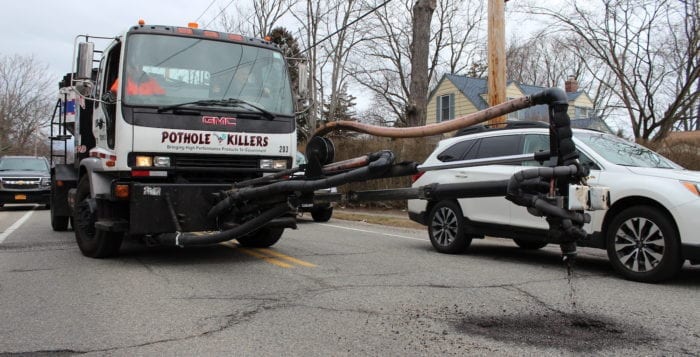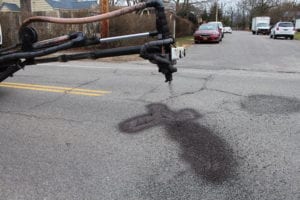Huntington to test Pothole Killer on local roads
New machine fills a depression in 60 to 90 seconds; can repair more than 100 per day

Huntington Town officials are excited to be taking the Pothole Killer out for a test run on the local roadways. Hopefully, it will mean a smoother ride for all.
Kevin Orelli (D), Huntington’s Superintendent of Highways, unveiled that the town has struck an agreement with Patch Management, Inc. to try out a one-man spray-injection machine to repair potholes and cracks in Huntington’s roads during the next several months.

“We’ve been repairing potholes for than 50 years in the same method,” ORelli said. “We want to bring the Town of Huntington into the 21st century and use a new, more efficient method to do that work.”
Currently, Orelli said he sends out a crew of highway department workers with a hotbox containing hot asphalt to lay down a patch over the pothole. He estimated that a crew can fill approximately 40 potholes a day using this method.
Scott Kleiger, the inventor of the Pothole Killer with Patch Management said his machine can fill the average pothole in 60 to 90 seconds, with a skilled operator repairing more than 100 per day.
The Pothole Killer is run by a trained operator who remains inside the cab of the truck at all times, according to Kleiger, avoiding the roadway hazard of oncoming traffic.
“One of the key elements of this is safety,” he said as a former public works employee. “The job they do out there for the common good of the people is very dangerous and very tedious.”
Using a joystick, the machine’s operator positions an external arm over the crack or pothole which blows pressurized air into it, removing all loose debris. The machine is used to spray an asphalt emulsion, or “tack coat,” that provides an adhesive base for the filler material to bond to. Next, the machine coats aggregate filler in the asphalt emulsion to fill the hole or crack to surface level. Last, dry material is sprayed over the top of the repair.

“The roadway is open immediately, as it doesn’t stick to their tires,” said Brian Rutledge, a field sales agent for Patch Management.
Rutledge said the Pothole Killer is currently used in 10 states, including by Rhode Island and New Jersey Department of Transportation. Resident may be able to see the machine in action as New York State Department of Transportation uses it to fill holes and cracks along the Long Island Expressway.
Huntington Supervisor Chad Lupinacci (R) said that given this winter’s extreme cold weather, he anticipates it will be particularly bad year for potholes. The town has received more than 500 phone calls, according to Orelli, and already repaired more than 2,000 potholes this year.
“We expect the situation to get worse over the next several weeks, especially as we enter the spring season,” Lupinacci said.
Drivers can report developing cracks and potholes by visiting the town’s website at www.huntingtonny.gov, and going to Highway Department page, or by calling the Highway Operations Center directly at 631-499-0444.






